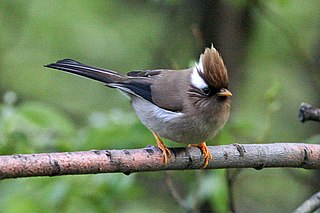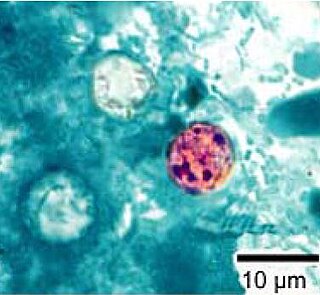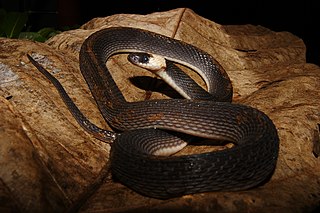
Ninia atrata, known commonly as Hallowell's coffee snake, Hallowell's earth snake, the red-nape snake, and the South American coffee snake, is a species of small terrestrial snake in the family Colubridae. The species is native to southern Central America and northern South America.

Python is a genus of constricting snakes in the Pythonidae family native to the tropics and subtropics of the Eastern Hemisphere.

The white-tailed alethe is a species of bird in the Old World flycatcher family Muscicapidae. It is found in western Africa from Senegal to Togo. Its natural habitat is subtropical or tropical moist lowland forests.

The white-collared yuhina is a bird species in the white-eye family Zosteropidae.

The red-fronted barbet is a species of bird in the Lybiidae family. It is found in Ethiopia, Kenya, South Sudan, Tanzania, and Uganda.

The fire-crested alethe is a species of bird in the Old World flycatcher family Muscicapidae. It is found in central Africa, from Nigeria to Uganda. Its natural habitat is subtropical or tropical moist lowland forests.

Ninia sebae, commonly known as the redback coffee snake or the red coffee snake, is a species of small terrestrial snake in the family Colubridae. The species is native to southeastern Mexico and Central America south to Costa Rica. Although it resembles some venomous coral snakes in color and size, it is not venomous and seldom bites humans.

Ninia is a genus of snakes, commonly referred to as coffee snakes, in the subfamily Dipsadinae of the family Colubridae of the superfamily Colubroidea. The genus consists of 12 species that are native to southeastern Mexico, Central America, and the northern part of South America. Some species are also found on the Caribbean islands.

The Maracaibo wood turtle is a species of turtles in the family Geoemydidae. The species is endemic to northern South America.

Cyclospora is a genus of apicomplexan parasites. It includes the species Cyclospora cayetanensis, the causative agent of cyclosporiasis. Members of Cyclospora are characterized as having oocysts with two sporocysts, each containing two sporozoites.

Alchemilla diademata, also known as the diadem lady's mantle, is a species of the genus Alchemilla endemic to Lebanon. The plant has been commonly used in folk medicine in Lebanon and its promising bioactive properties have been subject to a number of studies.
Ninia celata is a species of snake in the family Colubridae. The species is native to Costa Rica and Panama.
Ninia espinali, Espinal's coffee snake, is a species of snake in the family Colubridae. The species is native to Honduras and El Salvador.
Ninia franciscoi, the Simla coffee snake, is a species of snake in the family Colubridae. The species is native to Trinidad.

Ninia hudsoni, also known commonly as the Guyana coffee snake and Hudson's coffee snake, is a species of snake in the family Colubridae. The species is native to northwestern South America.
Ninia maculata, the Pacific banded coffee snake or spotted coffee snake, is a species of snake in the family Colubridae. The species is native to Guatemala, Honduras, Nicaragua, Costa Rica, and Panama.
Ninia pavimentata, the northern banded coffee snake, is a species of snake in the family Colubridae. The species is native to Guatemala and Honduras.
Ninia psephota, the red-bellied coffee snake or Cope's coffee snake , is a species of snake in the family Colubridae. The species is native to Panama and Costa Rica.











